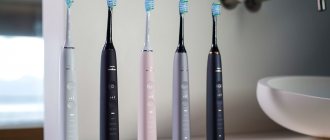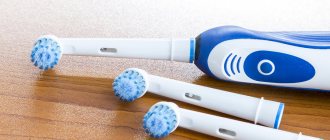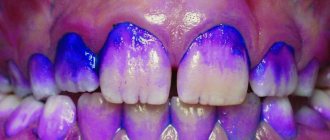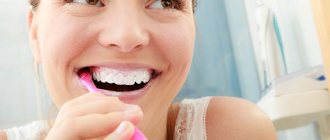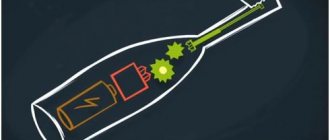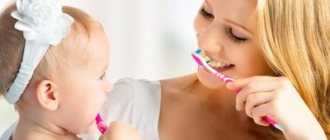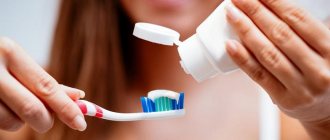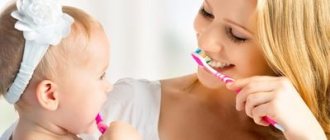Today, more and more people are deciding to switch from using regular toothbrushes to electric ones. This is a completely rational solution, which is aimed not only at making cleaning easier, but also at increasing the effect of using the brush. However, most people mistakenly believe that brushing teeth is a very simple procedure that does not have any nuances. This is not true, and today we want to figure out how to use an electric toothbrush so that the result of its use is positive and obvious.
Of course, one of the most important aspects of maintaining oral hygiene is systematically brushing your teeth 2 times a day. However, these are not all the subtleties that you should know about. And below we will try to analyze step by step the most important aspects and nuances that can teach you how to use an electric toothbrush correctly.
Seventh step
When the teeth cleaning procedure is completed and the oral cavity is clean, you need to take care of the electric toothbrush itself. Most brushes are waterproof and invulnerable to moisture, so the device can be safely rinsed under running water. This can be done in just a few seconds.
After cleaning the brush, it must be placed in a vertical position. This can be done using a regular glass. The glass, of course, must be dry and clean.
Cleaning the outside of your teeth
A mandatory rule is the conditional division of the oral cavity into parts: upper (right and left) and lower (right and left). This is necessary to improve the quality of cleaning in order to treat all areas.
- The hygiene procedure can be started from any quarter. The time spent on this is up to 40 seconds. The surface of each unit is cleaned separately.
- The procedure needs to start from the outside, then move on to the inside. The movements should be sweeping, their direction should be up and down.
- First, the head is applied to the edge of the gums, then moved to the chewing plane of the unit. There is no need to keep the device in one area for a long time.
At the first stage of the hygiene procedure, the outside is always cleaned. It is more convenient to start with the upper jaw. Quality indicators will be enhanced by the smooth movement of the head from tooth to tooth with a delay of no more than 1-2 seconds. This is easy as the device is programmed with the correct rotation method.
Ninth step
Check if the toothbrush is dry, and if the answer to this question is yes, place it on a special stand. If the brush's charge is low, it is recommended to place it in the charging station in a timely manner so that the device is fully ready for use by the next time you brush your teeth. If the brush is set to recharge, we recommend that you monitor the charging process by turning off the gadget in a timely manner, because excessive charging installation time will not benefit the brush.
Advantages of the device
Electric toothbrushes have many benefits:
- This device provides a whole range of possibilities for cleaning, massage and care of the oral cavity.
- Moving bristles and several operating modes facilitate and speed up the cleaning process, and also allow you to thoroughly clean interdental spaces and hard-to-reach places, such as “sevens” and “eights.”
- Electric brushes make it much easier to care for orthodontic braces.
- Electric brushes deal with stains from tea or coffee 21% better than a regular manual brush, and with gingivitis - about 11%.
- Using an electric brush prevents the possibility of injury to the gums or destruction of enamel. Provided proper operation and the correct choice of attachments, cleaning with this device is less traumatic.
- Children love brushing their teeth with a children's electric toothbrush. This makes the boring morning ritual interesting for them and they perform it with more enthusiasm.
Important! If you decide to purchase an electric toothbrush, then don’t skimp. Remember, a high-quality device cannot be cheap. The price of branded models starts from 7 thousand rubles. By choosing a cheaper device, you risk buying a fake, which can quickly break down, or, even worse, harm your health.
Brushes from different manufacturers
As you know, on the modern market there is a fairly wide range of different manufacturers involved in the creation and sale of electric toothbrushes. Perhaps the most popular of them are the following companies:
- Braun Oral-B;
- Philips;
- Colgate.
They all produce brushes with different parameters and operating modes, which is why each device may have its own nuances of use. Fortunately, today it is not so difficult to find official video tutorials on how to use an electric toothbrush from a particular manufacturer.
However, as regards the actual procedure of brushing teeth, all manufacturers agree that the option of brushing teeth by sectors (dividing the oral cavity into four conventional parts) is ideal.
Cleaning gums
Daily hygienic cleaning of the oral cavity at home prevents inflammation of soft tissues and dental diseases.
- The gums are cleaned when the device is turned off.
- A special attachment is used to clean and massage mucous membranes.
- The palate and tongue are processed.
- You need to act carefully so as not to damage the soft tissues and not cause receding gums.
- The movements should be light, the direction should be back and forth.
After cleaning, rinse your mouth with clean water or a special product. This will improve the condition of soft and hard tissues. People with sensitive and painful gums can use the miracle device no more than once every 7-10 days. Patients with oral problems should consult a dentist.
How to properly care for your electric toothbrush
Finally, it is necessary to consider some more very important nuances for caring for an electric toothbrush. If you want your device to serve you as long as possible without any problems, we recommend that you listen to these tips.
The first of these tips is the rules for storing brushes outside the home, that is, when traveling and travelling. Often, EZHs are used directly for greater convenience when traveling, but unsanitary conditions are typical for trains and other vehicles in which we have to brush our teeth. Therefore, it is recommended to store electric brushes in such conditions exclusively in special cases and boxes.
Another nuance that you should be aware of concerns the use of special disinfectants for electric toothbrushes. As we have already noted, brushes must be cleaned and rinsed after use. However, if you want to be sure that your toothbrush is as disinfected as possible, it is recommended to use a device such as a disinfector or sterilizer.
These are special devices in which brushes are dried and disinfected using ultraviolet light, thereby acquiring the most appropriate appearance for further use. Some brushes are supplied with such a device, but such a set can be seen in more expensive device models. Budget electric brushes require the purchase of an additional sterilizer.
By following all these rules, you will very quickly learn how to use an electric toothbrush, as well as how to properly care for it.
Chewing teeth
Manipulations on the chewing organs are carried out as carefully as possible with special attention. They are at high risk of pulpitis and caries.
- The surface of the molars is cleaned from all sides.
- When brushing, lightly press the brush to treat the space between the teeth.
- For high-quality treatment of the interdental space, a special thread is used. Dentists recommend flossing daily. You need to tear off 50 centimeters of thread and wrap the ends around your fingers. Using your thumbs to pull the center section taut, gently move the floss between the molars. Near the gum tissue, you need to floss around the surface of the chewing organ.
- The lateral part of the molar is wiped with thread. This will remove any bacteria buildup.
It is better to start the hygiene procedure with floss, and then work with a brush. Devices with 2D technology (forward-reciprocating movements) and 3D technology (with the addition of pulsation) perfectly process molars, removing pathological plaque.
Precautionary measures
If you have chosen an electric brush for daily oral care, then do not forget about the need to constantly monitor the pressure of the device on the tissue of the gums and teeth.
It is important to know that excessive force can cause soft tissue injury or damage to the enamel layer of the teeth.
To save money, we recommend purchasing one device for the whole family . Only individual nozzles will have to be changed.
For those who care about the cleanliness and health of their teeth, dentists recommend using electric or sonic brushes. As you can see, using such a device is simple and convenient. With the help of our tips, you will master the art of competent hygienic oral care. And perhaps, once you try an electric brush, you will never go back to using a manual one.
How about cleaning your tongue? If yes, then with what?
Bacteria that cause tooth decay also multiply on the tongue. But there is no evidence that everyone needs to clean it. A study of 251 subjects found that brushing the tongue helps get rid of bad breath - halitosis.
. But there is no exact data on how often and for how long to clean your tongue, what technique to use.
Manufacturers offer special tongue scrapers
, which do not cause a gag reflex, and recommend brushing your tongue twice a day after brushing your teeth. You should start from the root of the tongue, where most bacteria accumulate. Using gentle pressure, you first need to move from the root of the tongue to its tip, and then treat the side surface, right and left.
Does everyone need an irrigator?
First of all, it is needed by those who find it difficult to floss: people with orthodontic structures such as braces and implants, those who have not had their wisdom teeth removed and the space between the teeth is too small to clean with dental floss, and people with disabilities. An irrigator will also come in handy if your gums are sensitive and dental floss causes them to bleed.
Some data say that floss cleans the interdental spaces better, others say that an irrigator does. So the choice between a thread and an irrigator is more a matter of convenience
. You can even use both: this is the most effective way to remove plaque between teeth.
Choice
Before purchasing an electric toothbrush, it is advisable to visit your dentist. After examining the condition of your teeth, the doctor will help you decide which product to choose and how to use it.
When purchasing an electric toothbrush, you must rely on the following rules:
- It is advisable to buy devices with a bowl-shaped or round head.
- It is important to pay attention to the pressure indicator; this function will prevent strong pressure on the teeth and gums, which will protect against injury.
- When choosing this device, you need to pay attention that the kit includes replaceable attachments that need to be changed periodically.
- There are different attachments - for cleaning, whitening, sensitive gums, children's, for crowns or bridges. The greater their number, the more versatile the product.
- The timer helps to evenly brush the upper and lower rows of teeth and protects against strong or insufficient exposure to a specific area.
Is pressing required?
The cleaning process does not require special pressure, as this is harmful to the enamel. Even low power attachments operate at 4000 rpm. You just need to turn on the required mode: maximum or gentle cleaning.
Some modern models have sensors that control the pressure applied, as well as a timer that shows the time required to clean a segment of the dentition. Electronic “smart” devices are very convenient to use, but they are also expensive: the cost starts from 7-10 thousand rubles.
Contraindications for use
In addition to the benefits and pleasure of use, electric brushes also have a number of contraindications and disadvantages :
- Before you start using the device, it is advisable to obtain the approval of your dentist, who will evaluate the condition of your teeth. You will also receive the necessary advice and recommendations.
- Those people who have sore or weak gums are not recommended to use an electric toothbrush every day. You can alternate it with a manual analogue and monitor your well-being.
- Thin, sensitive enamel can also be damaged by thorough cleansing with an electric brush.
- The use of an electric toothbrush is contraindicated for people with serious heart disease.
- The main disadvantage of the device is the high cost of the device itself and the attachments, which must be changed regularly.
